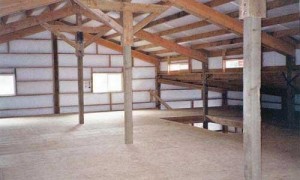 It’s not uncommon to construct a loft in a pole building – after all, construction is so affordable that you’re going to be left with excess funds that you can pour right back into your investment. They take up almost no space and can sometimes even add space to an existing interior. If you’re on the fence about putting in a pole barn loft, consider the following.
It’s not uncommon to construct a loft in a pole building – after all, construction is so affordable that you’re going to be left with excess funds that you can pour right back into your investment. They take up almost no space and can sometimes even add space to an existing interior. If you’re on the fence about putting in a pole barn loft, consider the following.
1. It Looks Amazing
With a little elbow grease and a few inspiring ideas, you can create new and exciting atmospheres in your pole barn. Loft areas retain the wide open feeling characteristic of the pole building while adding an aesthetic touch that is completely customizable.
Construct a loft, then whitewash the walls and ceiling to expand the already impressive dimensions of your pole barn. Even a pole barn loft with wall support disappears into your surroundings when you treat the interior with a color that blends well in any light.
Alternatively, you can create a western look by installing distressed metallic railings alongside natural, worn, and treated wood on your loft. Accent it with secondhand or recycled furniture to cultivate an air of a time long ago.
The possibilities truly don’t end. Adding a loft in your pole building gives you the freedom to revolutionize your barn’s aesthetic quickly and easily without overhauling the entire building.
2. It Utilizes Vertical Space
Pole buildings are famously tall, which means that the ceilings can be imposing. All that extra space rarely goes to good use. It may be liberating to keep the space wide open, but if you want to maximize the potential of your pole building, you’ll want to take advantage of the wide open areas left by the unique roofing structure.
Fortunately, you can build up as high as you want. Supports for pole buildings run mostly along the frame, so you also have a large open area well below the ceiling to place staircases and ladders. That means there’s no limit to the height of your pole barn’s loft. You can even layer or bunk your loft so that you have multiple levels – just make sure your building is able to support the extra weight.
3. It Increases Storage
When there’s no more room for your stuff downstairs, move everything upstairs! A loft is like an oversized shelf – you can place things underneath it and stack them to the top, and you can place things on it safely and easily.
Even better, you can double the stairs or ladder you place to get to your loft as extra storage. Build more shelving into your stairs or underneath your ladder to expand your small storage options so there’s more room above and below your loft to put the big stuff, including furniture and appliances.
4. It’s Versatile
Even if your pole barn isn’t your house, you can still transform the extra space above into useful areas. Here are some ideas for your pole barn loft:
- Sitting area – Place some comfy furniture and a coffee table to create a social space for coffee or casual meetings.
- Home Office – Free your workspace at home by transforming your loft with desks, chairs, and drawers.
- Library – Install extra shelving up top to store your vast collection of literature and reference books.
- Craft Room – Bring in long, wide tables for crafting and build cubbies to protect your crafting materials.
- Study – Arrange long couches and luxurious chairs to create a space for concentration and learning.
- Game Room – Get a foosball or pool table with a bit of bar seating for game time with friends.
- Lounge – Install a small bar with a few comfortable seats to create your own lounge area.
- Gym – Equip your pole barn loft with workout machines and free weights so you never have to buy another gym membership.
- Utility – Set up your washer and dryer or build a workshop in your extra ceiling space.
5. It’s Easy to Build
You can use the support from your pole barn or place your loft on its own supports, but building a loft isn’t as tough as it sounds. It’s not very time consuming and only requires a small amount of raw materials to put together. Your small investment in time and resources will increase the utility and value of your pole building many times, and you’ll enjoy having a beautiful, useful, and customizable space where there was only emptiness before.
 For a full loft (sidewall-to-sidewall), at the very least there should be four feet of height above the loft floor at the outside eave wall. As floor and roof systems have a thickness – use this for a guideline:
For a full loft (sidewall-to-sidewall), at the very least there should be four feet of height above the loft floor at the outside eave wall. As floor and roof systems have a thickness – use this for a guideline:





